 A good book to help those of us living on tiny urban lots, or in the even smaller spaces of condominiums and townhouses is Big Ideas for Northwest Small Gardens by Marty Wingate. It guides the city gardener through design consideration and appropriate plant selection. One chapter answers common questions city gardeners have, such as “Can I have a wildlife garden?” Color photography by Jacqueline Koch helps make this informative book a pleasure to read.
A good book to help those of us living on tiny urban lots, or in the even smaller spaces of condominiums and townhouses is Big Ideas for Northwest Small Gardens by Marty Wingate. It guides the city gardener through design consideration and appropriate plant selection. One chapter answers common questions city gardeners have, such as “Can I have a wildlife garden?” Color photography by Jacqueline Koch helps make this informative book a pleasure to read.
Archives: Book Reviews
Reviews of recommended books by Miller Library staff and volunteers.
Food grown right, in your backyard : a beginner’s guide to growing crops at home
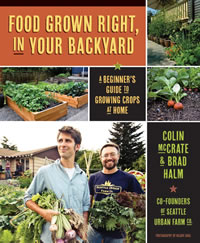 The Seattle based authors of Food Grown Right, in Your Backyard operate a business that gets homeowners started growing their own vegetables (along with herbs, edible flowers, and a few berry fruits) no matter what the challenges may come from inexperience or a difficult site. Colin McCrate and Brad Halm advice is great for beginners, providing a lot of structure and many details while including a teaching element with every entry. For example, by growing radishes you’ll learn how to harvest at the right time for the best taste, while planting corn will teach you about wind pollination.
The Seattle based authors of Food Grown Right, in Your Backyard operate a business that gets homeowners started growing their own vegetables (along with herbs, edible flowers, and a few berry fruits) no matter what the challenges may come from inexperience or a difficult site. Colin McCrate and Brad Halm advice is great for beginners, providing a lot of structure and many details while including a teaching element with every entry. For example, by growing radishes you’ll learn how to harvest at the right time for the best taste, while planting corn will teach you about wind pollination.
Excerpted from the Winter 2013 Arboretum Bulletin.
Growing at the speed of life : a year in the life of my first kitchen garden
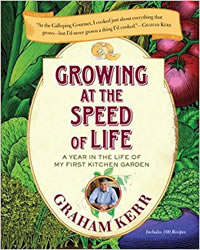 Graham Kerr is an (now local–Mt. Vernon) author who easily includes recipes amongst his recommendations for a kitchen garden, but that’s not surprising as he is much better known as a chef (remember the Galloping Gourmet) than a gardener. He has embraced raising his own, healthful food as eagerly as any of his past pursuits. Growing at the Speed of Life is filled with the same enthusiasm–Kerr hasn’t lost any of his wit or knack of turning a phrase that made him such a popular television personality in the early 1970s.
Graham Kerr is an (now local–Mt. Vernon) author who easily includes recipes amongst his recommendations for a kitchen garden, but that’s not surprising as he is much better known as a chef (remember the Galloping Gourmet) than a gardener. He has embraced raising his own, healthful food as eagerly as any of his past pursuits. Growing at the Speed of Life is filled with the same enthusiasm–Kerr hasn’t lost any of his wit or knack of turning a phrase that made him such a popular television personality in the early 1970s.
Excerpted from the Winter 2013 Arboretum Bulletin.
Modern Homestead : Grow, Raise, Create
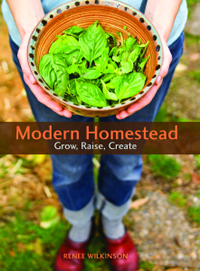 Drawing a parallel with the homesteaders who settled the Oregon frontier, Portland author Renee Wilkinson recognizes that same spirit–and lack of knowledge and experience–in today’s pioneers seeking self-sustaining, urban homes. Modern Homestead is not an A-Z encyclopedia of vegetable crops, but instead provides general rules-of-thumb to help you decide what you want, including a sizeable portion of the book that is given over to “Citified Creatures.” Preserving your harvest is important, too, but the strongest message is don’t work alone. Find some buddies to help you with your homestead, and you will collectively be more innovative and much more successful.
Drawing a parallel with the homesteaders who settled the Oregon frontier, Portland author Renee Wilkinson recognizes that same spirit–and lack of knowledge and experience–in today’s pioneers seeking self-sustaining, urban homes. Modern Homestead is not an A-Z encyclopedia of vegetable crops, but instead provides general rules-of-thumb to help you decide what you want, including a sizeable portion of the book that is given over to “Citified Creatures.” Preserving your harvest is important, too, but the strongest message is don’t work alone. Find some buddies to help you with your homestead, and you will collectively be more innovative and much more successful.
Excerpted from the Winter 2013 Arboretum Bulletin.
Handmade Garden Projects
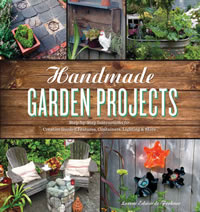 Lorene Edwards Forkner has addressed a real need on the Garden Library bookshelf. While there are a handful of books (none of them by local authors) about using foraged materials for garden decoration, none adequately take the next step of using these materials to create useful yet attractive objects that we all need in our gardens. Handmade Garden Projects has everything from fountains to potting benches with clear instructions and lots of encouragement to build these yourself, at a fraction of the cost of having someone else be your handy man or woman. Another plus: many of the examples are from gardens created by familiar people in the Seattle area horticultural community.
Lorene Edwards Forkner has addressed a real need on the Garden Library bookshelf. While there are a handful of books (none of them by local authors) about using foraged materials for garden decoration, none adequately take the next step of using these materials to create useful yet attractive objects that we all need in our gardens. Handmade Garden Projects has everything from fountains to potting benches with clear instructions and lots of encouragement to build these yourself, at a fraction of the cost of having someone else be your handy man or woman. Another plus: many of the examples are from gardens created by familiar people in the Seattle area horticultural community.
Excerpted from the Winter 2013 Arboretum Bulletin.
The Lavender Lover’s Handbook

Many urban farming and vegetable gardening books include lavender as a staple plant, but “The Lavender Lover’s Handbook” provides much greater detail on the particular needs and benefits of these sub-shrubs. Sarah Berringer Bader is a lavender farmer in western Oregon and shares her expertise on selection, planting, maintaining, harvesting, and–yes!–cooking with lavender. Best is her selection of cultivars for various purposes such as best scent, richest color (in various hues), or in a landscape. She even includes the best choices for using in her recipes. An encyclopedia of available varieties is quite thorough and enhanced by Janet Loughrey’s skilled photography.
Excerpted from the Winter 2013 Arboretum Bulletin.
Apartment Gardening
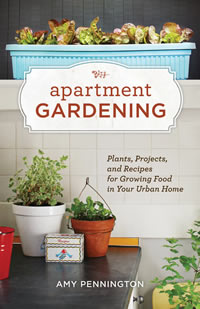 Apartment Gardening takes the whole concept of gardening in your available space a step farther, or I should say, smaller. Amy Pennington has considerable gardening experience in a setting with plentiful space, but now confined to a Seattle apartment, she wasn’t about to stop. She distills her plant selections to a short but well-tested list. Some surprised me (zucchini on a balcony?) but overall I was impressed by the what-works approach. Large compost bins are out, but worm bins are still possible; she even advocates a beehive on the deck. But check with the neighbors first! Hers nixed the idea. Helpful recipes use only the plants listed, and include making lip balms and lotions, and herbal teas.
Apartment Gardening takes the whole concept of gardening in your available space a step farther, or I should say, smaller. Amy Pennington has considerable gardening experience in a setting with plentiful space, but now confined to a Seattle apartment, she wasn’t about to stop. She distills her plant selections to a short but well-tested list. Some surprised me (zucchini on a balcony?) but overall I was impressed by the what-works approach. Large compost bins are out, but worm bins are still possible; she even advocates a beehive on the deck. But check with the neighbors first! Hers nixed the idea. Helpful recipes use only the plants listed, and include making lip balms and lotions, and herbal teas.
Excerpted from the Winter 2013 Arboretum Bulletin.
The Dirt-Cheap Green Thumb
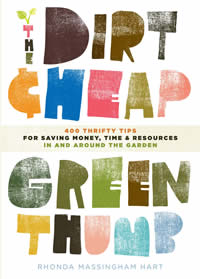 Massingham Hart has re-engineered another of her older titles with “Dirt-Cheap Green Thumb”. This is essentially a general gardening book (including ornamentals) packaged in short, snappy bits of information and is perfect for the newer gardener who is anxious to get started right now. The reader who is frugal will even be more pleased as there are lots of tips (400 according to the sub-title) for saving money while growing the garden of your dreams.
Massingham Hart has re-engineered another of her older titles with “Dirt-Cheap Green Thumb”. This is essentially a general gardening book (including ornamentals) packaged in short, snappy bits of information and is perfect for the newer gardener who is anxious to get started right now. The reader who is frugal will even be more pleased as there are lots of tips (400 according to the sub-title) for saving money while growing the garden of your dreams.
Excerpted from the Winter 2013 Arboretum Bulletin.
Vertical Vegetables and Fruit
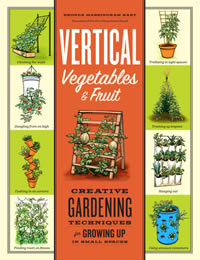 Here is another approach to dealing with limited space: grow up. Vertical Vegetables and Fruit is one of the very few books focused on this technique of food-growing. Some of the featured vegetables and fruits are naturals (beans or kiwi), but many are not. And while the thought of a high-flying watermelon may take a bit of getting used to, the author devotes several pages to slings and other support devices to make this possible. There are many unconventional ideas here to try, including hanging bags and living walls, along with some more familiar espaliers of fruit trees and strawberry pots. The emphasis is on innovation and experimentation–and having fun with your veggies (and fruit)!
Here is another approach to dealing with limited space: grow up. Vertical Vegetables and Fruit is one of the very few books focused on this technique of food-growing. Some of the featured vegetables and fruits are naturals (beans or kiwi), but many are not. And while the thought of a high-flying watermelon may take a bit of getting used to, the author devotes several pages to slings and other support devices to make this possible. There are many unconventional ideas here to try, including hanging bags and living walls, along with some more familiar espaliers of fruit trees and strawberry pots. The emphasis is on innovation and experimentation–and having fun with your veggies (and fruit)!
Excerpted from the Winter 2013 Arboretum Bulletin.
Winter Gardening in the Maritime Northwest
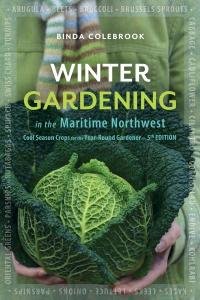
Binda Colebrook is on her fifth edition (the first from 1977) of the classic “Winter Gardening in the Maritime Northwest,” and it’s still a must for any serious food gardener. The emphasis is on crops that will grow throughout the year, so no tomatoes or corn, but instead you’ll discover many options that are really better suited for our mild climate. There is much emphasis on ways to reduce the impact of freezes, heavy rains, and cold winds, but Colebrook is great at encouraging experimentation even if your property doesn’t have perfect conditions. An excellent reference section completes the book.
Excerpted from the Winter 2013 Arboretum Bulletin.